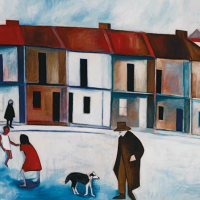90. ROBERT DICKERSON

Robert Dickerson had always possessed an affinity for Sydney, a love affair that he maintained throughout his career. Compelled to paint his surroundings, Dickerson chose to capture the close-at-hand realities of his environment and in turn, Sydneys atmosphere and a way of life that has all but disappeared in the twenty-first century.
Dickerson was born in the front room of his parents Hurstville home and grew up in Surry Hills during the Depression years of the 1930s. The inner city was not salubrious, but Dickerson thrived in it, viewing the streets as his playground and a place he could escape to.1 Throughout his lifetime, Dickerson came and went from Sydney, first leaving to join the war effort in 1939 and later venturing to Queensland and subsequently New York, Tokyo and London. Dickerson achieved some international success culminating in a solo exhibition at the Qantas Gallery in London in 1973. Although he enjoyed his time abroad, Dickerson yearned for the inner-city life of Sydney, inevitably returning in 1979 to a terrace house in Woollahra which is now home to the notable Dickerson Gallery.2
It was during this time that Dickerson created a body of work known as the Paddington/Woollahra pictures that were born from his personal interactions with the city. He would often walk the streets to look at buildings, shadows, and people, returning to his studio and capturing them in a unique and angular style that has become synonymous with Australian figurative painting. The Tenants highlights the pared-back rawness that endures within Dickersons painting. Before a row of tightly packed terrace houses, a man beckons to his dog. Two children play in the street, while an enigmatic figure shuffles along the pavement behind them.
Dickersons move back to Sydney was partly motivated by his love for the hustle and bustle of city life, but it also allowed him to spend time with his young daughter Camilla who, with her piquant figure and long dark hair, resembles the girl in the red dress in the present work. Although Dickerson craved the trappings of city life, a sense of tranquillity and simplicity is felt in the canvas. Dickerson had an uncanny ability to create snapshots of universally recognisable scenes, allowing the viewer to reflect on simpler times.
A comparable scene is not as easily portrayed in the streets of Paddington in 2022. Certain similarities endure, such as lanes of terrace houses, but the streets would be lined with rows of VW Golfs, walkers in activewear, and children glued to devices. Hal Missingham, former director of the Art Gallery of New South Wales, notes, The most endearing thing about Bobs pictures is that they are about humans, not effigies or abstractions or cerebral adventures but a clear-cut interest in everyday people.3 The Tenants is an evocation of memory, allowing the viewer to be transported to a Paddington unknown by its inhabitants today. Dickerson draws on memories from his childhood and in turn his childrens upbringing, to highlight the simplicity of twentieth-century life in the inner suburbs of Sydney.
Footnotes:
1. Dickerson, J., Robert Dickerson: Against the Tide, Pandanus Press, Brisbane, 1994, p.18
2. Dickerson, J., op. cit., p.109
3. Artists Profile: Robert Dickerson, Art Gallery of New South Wales, Sydney, (accessed October 2022): https://www.artgallery.nsw.gov.au/collection/artists/dickerson-robert/
Clementine Retallack